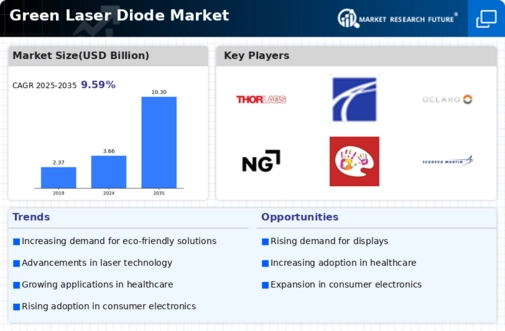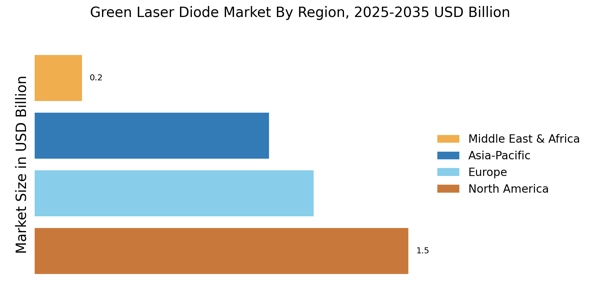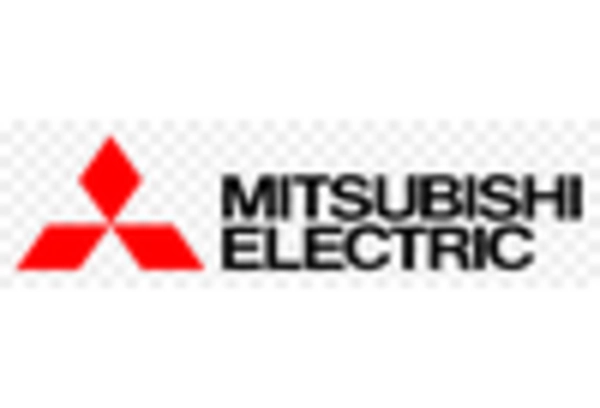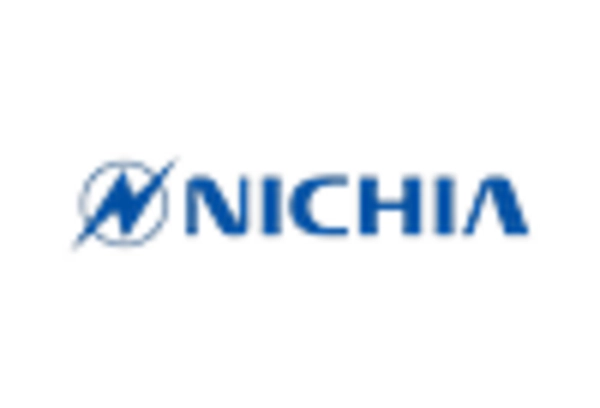Advancements in Medical Applications
The Green Laser Diode Market is significantly influenced by advancements in medical applications, particularly in surgical and diagnostic procedures. Green laser diodes are increasingly utilized in various medical devices, including laser surgery equipment and phototherapy systems. The Green Laser Diode Market is anticipated to grow at a compound annual growth rate of around 10% through 2025, reflecting the rising adoption of laser technologies in healthcare. This growth is indicative of the increasing reliance on precision and minimally invasive techniques in medical practices. As healthcare providers seek to enhance patient outcomes, the integration of green laser diodes into medical devices is likely to expand, thereby driving demand within the Green Laser Diode Market. The potential for innovation in this sector suggests a promising future for green laser diodes in medical applications.
Expansion in Industrial Applications
The Green Laser Diode Market is witnessing expansion in industrial applications, particularly in manufacturing and automation processes. Green laser diodes are utilized in various industrial applications, including laser marking, engraving, and cutting. The industrial laser market is projected to grow at a compound annual growth rate of approximately 8% through 2025, indicating a robust demand for laser technologies in production environments. This growth is driven by the need for precision and efficiency in manufacturing processes. As industries increasingly adopt automation and advanced manufacturing techniques, the role of green laser diodes is likely to become more prominent. This trend suggests that the Green Laser Diode Market will continue to evolve, driven by the integration of laser technologies in industrial applications.
Increased Focus on Energy Efficiency
The Green Laser Diode Market is benefiting from an increased focus on energy efficiency across various sectors. As industries strive to reduce their carbon footprint, the demand for energy-efficient technologies is on the rise. Green laser diodes, known for their low power consumption and high output efficiency, are becoming a preferred choice in applications ranging from lighting to industrial machinery. The global push towards sustainability is reflected in the anticipated growth of the energy-efficient lighting market, which is expected to exceed 100 billion USD by 2025. This trend suggests that businesses are increasingly adopting green technologies to comply with regulatory standards and meet consumer expectations. As a result, the Green Laser Diode Market is likely to see a significant uptick in demand as companies seek to implement energy-efficient solutions.
Rising Demand in Consumer Electronics
The Green Laser Diode Market is experiencing a notable surge in demand driven by the proliferation of consumer electronics. Devices such as smartphones, tablets, and gaming consoles increasingly incorporate green laser diodes for enhanced display quality and energy efficiency. The market for consumer electronics is projected to reach approximately 1 trillion USD by 2025, indicating a robust growth trajectory. This trend suggests that manufacturers are prioritizing the integration of advanced laser technologies to meet consumer expectations for superior performance. As a result, the demand for green laser diodes is likely to escalate, positioning them as a critical component in the evolution of consumer electronics. Furthermore, the competitive landscape is intensifying, compelling companies to innovate and adopt green laser diodes to differentiate their products in a saturated market.
Growing Interest in Laser-Based Communication
The Green Laser Diode Market is poised for growth due to the increasing interest in laser-based communication technologies. As data transmission speeds become paramount, green laser diodes offer a viable solution for high-speed optical communication systems. The market for optical communication is projected to reach approximately 25 billion USD by 2025, driven by the demand for faster and more reliable data transfer. This trend indicates a shift towards utilizing laser technologies to enhance communication infrastructure. The unique properties of green laser diodes, such as their wavelength and efficiency, make them particularly suitable for applications in fiber optic networks. Consequently, the adoption of green laser diodes in communication systems is likely to accelerate, further solidifying their role in the Green Laser Diode Market.
















Leave a Comment